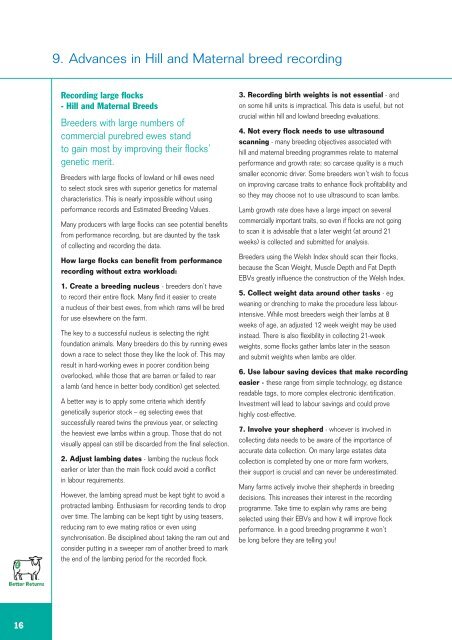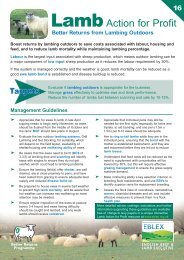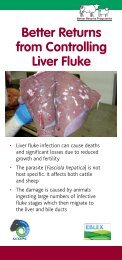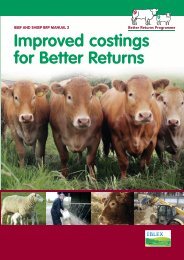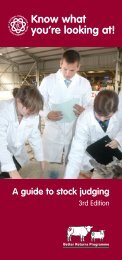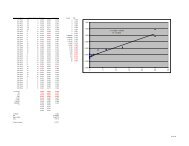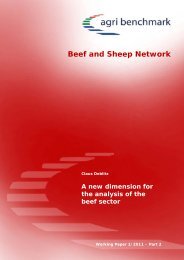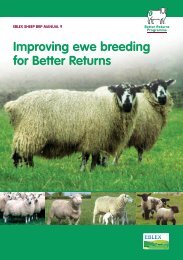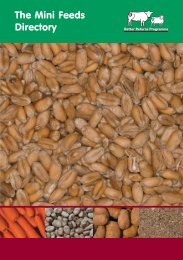Booklet - Breed a Better Pedigree Flock - Eblex
Booklet - Breed a Better Pedigree Flock - Eblex
Booklet - Breed a Better Pedigree Flock - Eblex
Create successful ePaper yourself
Turn your PDF publications into a flip-book with our unique Google optimized e-Paper software.
16<br />
9. Advances in Hill and Maternal breed recording<br />
Recording large flocks<br />
- Hill and Maternal <strong>Breed</strong>s<br />
<strong>Breed</strong>ers with large numbers of<br />
commercial purebred ewes stand<br />
to gain most by improving their flocks’<br />
genetic merit.<br />
<strong>Breed</strong>ers with large flocks of lowland or hill ewes need<br />
to select stock sires with superior genetics for maternal<br />
characteristics. This is nearly impossible without using<br />
performance records and Estimated <strong>Breed</strong>ing Values.<br />
Many producers with large flocks can see potential benefits<br />
from performance recording, but are daunted by the task<br />
of collecting and recording the data.<br />
How large flocks can benefit from performance<br />
recording without extra workload:<br />
1. Create a breeding nucleus - breeders don’t have<br />
to record their entire flock. Many find it easier to create<br />
a nucleus of their best ewes, from which rams will be bred<br />
for use elsewhere on the farm.<br />
The key to a successful nucleus is selecting the right<br />
foundation animals. Many breeders do this by running ewes<br />
down a race to select those they like the look of. This may<br />
result in hard-working ewes in poorer condition being<br />
overlooked, while those that are barren or failed to rear<br />
a lamb (and hence in better body condition) get selected.<br />
A better way is to apply some criteria which identify<br />
genetically superior stock – eg selecting ewes that<br />
successfully reared twins the previous year, or selecting<br />
the heaviest ewe lambs within a group. Those that do not<br />
visually appeal can still be discarded from the final selection.<br />
2. Adjust lambing dates - lambing the nucleus flock<br />
earlier or later than the main flock could avoid a conflict<br />
in labour requirements.<br />
However, the lambing spread must be kept tight to avoid a<br />
protracted lambing. Enthusiasm for recording tends to drop<br />
over time. The lambing can be kept tight by using teasers,<br />
reducing ram to ewe mating ratios or even using<br />
synchronisation. Be disciplined about taking the ram out and<br />
consider putting in a sweeper ram of another breed to mark<br />
the end of the lambing period for the recorded flock.<br />
3. Recording birth weights is not essential - and<br />
on some hill units is impractical. This data is useful, but not<br />
crucial within hill and lowland breeding evaluations.<br />
4. Not every flock needs to use ultrasound<br />
scanning - many breeding objectives associated with<br />
hill and maternal breeding programmes relate to maternal<br />
performance and growth rate; so carcase quality is a much<br />
smaller economic driver. Some breeders won’t wish to focus<br />
on improving carcase traits to enhance flock profitability and<br />
so they may choose not to use ultrasound to scan lambs.<br />
Lamb growth rate does have a large impact on several<br />
commercially important traits, so even if flocks are not going<br />
to scan it is advisable that a later weight (at around 21<br />
weeks) is collected and submitted for analysis.<br />
<strong>Breed</strong>ers using the Welsh Index should scan their flocks,<br />
because the Scan Weight, Muscle Depth and Fat Depth<br />
EBVs greatly influence the construction of the Welsh Index.<br />
5. Collect weight data around other tasks - eg<br />
weaning or drenching to make the procedure less labourintensive.<br />
While most breeders weigh their lambs at 8<br />
weeks of age, an adjusted 12 week weight may be used<br />
instead. There is also flexibility in collecting 21-week<br />
weights, some flocks gather lambs later in the season<br />
and submit weights when lambs are older.<br />
6. Use labour saving devices that make recording<br />
easier - these range from simple technology, eg distance<br />
readable tags, to more complex electronic identification.<br />
Investment will lead to labour savings and could prove<br />
highly cost-effective.<br />
7. Involve your shepherd - whoever is involved in<br />
collecting data needs to be aware of the importance of<br />
accurate data collection. On many large estates data<br />
collection is completed by one or more farm workers,<br />
their support is crucial and can never be underestimated.<br />
Many farms actively involve their shepherds in breeding<br />
decisions. This increases their interest in the recording<br />
programme. Take time to explain why rams are being<br />
selected using their EBVs and how it will improve flock<br />
performance. In a good breeding programme it won’t<br />
be long before they are telling you!


